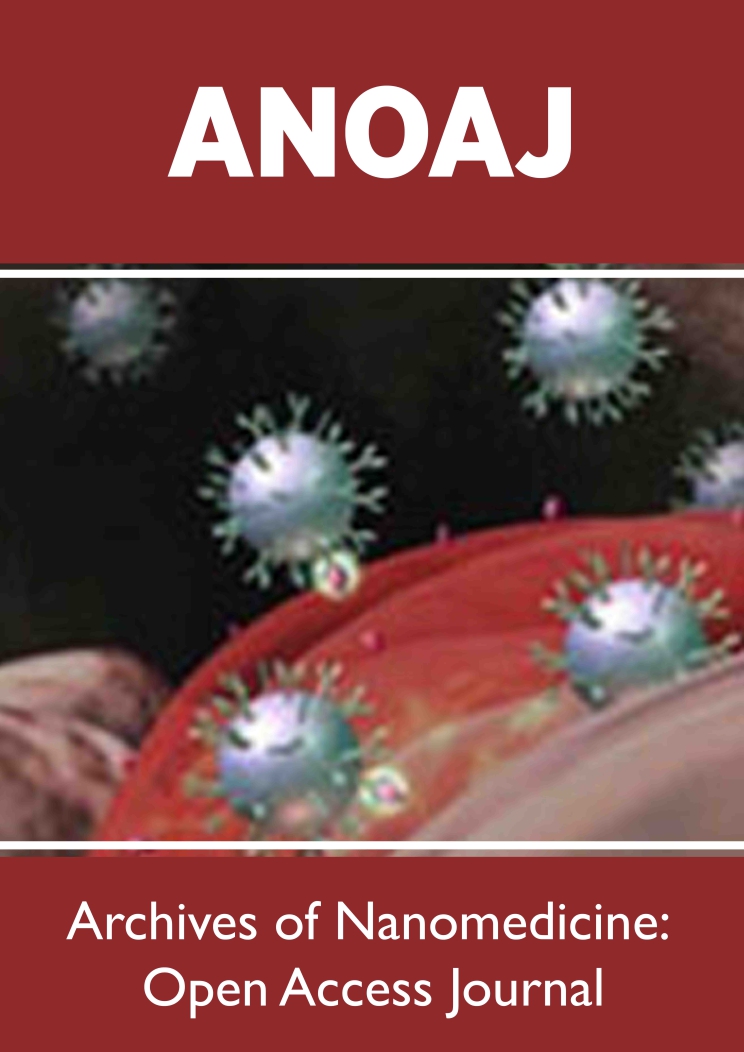-
Review ArticleView abstract
 PDF
PDF
 Full text
Metallic nanoparticles (MNPs) particularly the ones that are composed of silver, gold, copper, zinc, iron, and selenium revealed a noticeable role in medical applications like drug delivery systems, imaging, and therapeutic purposes. However, commercial production of these nanoparticles produces harmful byproducts to the environment and organisms. This is considered as a big limitation due to the increase in regulatory requirements to preserve environment...... ReadMore
Full text
Metallic nanoparticles (MNPs) particularly the ones that are composed of silver, gold, copper, zinc, iron, and selenium revealed a noticeable role in medical applications like drug delivery systems, imaging, and therapeutic purposes. However, commercial production of these nanoparticles produces harmful byproducts to the environment and organisms. This is considered as a big limitation due to the increase in regulatory requirements to preserve environment...... ReadMore -
EditorialView abstract
 PDF
PDF
 Full text
Over the last years, nanotechnology has been introduced in our daily life. Nanotechnology may be able to part in a very range of applications, such as in nanomedicine, nanoelectronics, biomaterials energy production, and consumer product, etc. The application of nanotechnology for medical purposes has been termed nanomedicine and is defined as nanoscale tools (e.g., 1–1000 nm sized) for the diagnosis, prevention, and treatment of diseases. The term nanomedicine appeared in the 1990s, and since then, has the potential to significantly improve some current treatments. Commonly, nanomedicines consist of active pharmaceutical ingredients such as small molecules or biologics packaged into nano-sized carriers made of excipients like lipids and polymers. By packaging drug in the particles, drug concentration in the target is maximize by passi..... ReadMore
Full text
Over the last years, nanotechnology has been introduced in our daily life. Nanotechnology may be able to part in a very range of applications, such as in nanomedicine, nanoelectronics, biomaterials energy production, and consumer product, etc. The application of nanotechnology for medical purposes has been termed nanomedicine and is defined as nanoscale tools (e.g., 1–1000 nm sized) for the diagnosis, prevention, and treatment of diseases. The term nanomedicine appeared in the 1990s, and since then, has the potential to significantly improve some current treatments. Commonly, nanomedicines consist of active pharmaceutical ingredients such as small molecules or biologics packaged into nano-sized carriers made of excipients like lipids and polymers. By packaging drug in the particles, drug concentration in the target is maximize by passi..... ReadMore -
Review ArticleView abstract
 PDF
PDF
 Full text
Systemic Fungal infection of skin is also known as mycosis. Mycosis is a common fungal infection affecting human skin and causes different dermatophyte infections. Fungal infections is panic rate which presenting number of challenge to healthcare professionals. This rising rate is directly related to the growing population of immune compromised individuals thus results from changes in medical practice like use of immunosuppressive drugs and rigorous chemotherapy. Now there are modern aggressive treatment was used to control fungal infection in the body. The purpose of this review is to highlight the different novel diagnostic approaches for treatments for fungal infections...... ReadMore
Full text
Systemic Fungal infection of skin is also known as mycosis. Mycosis is a common fungal infection affecting human skin and causes different dermatophyte infections. Fungal infections is panic rate which presenting number of challenge to healthcare professionals. This rising rate is directly related to the growing population of immune compromised individuals thus results from changes in medical practice like use of immunosuppressive drugs and rigorous chemotherapy. Now there are modern aggressive treatment was used to control fungal infection in the body. The purpose of this review is to highlight the different novel diagnostic approaches for treatments for fungal infections...... ReadMore -
Research ArticleView abstract
 PDF
PDF
 Full text
Highly altered Body Mass Index (BMI) and hypertension are independent and reversible determinants for coronary artery disease. Hypolipidemia can prevent hyperlipidemic patients to be victim of coronary artery disease. This study was conducted to compare hypolipidemic effects of Niacin and Jujube fruit in primary as well as secondary hyperlipidemic patients. Study was conducted from November 2015 to February 2016 at Jinnah Hospital Lahore, Pakistan. Sixty participants were enrolled of both gender male and female hyperlipidemic patients age range from 20 to 70 years...... ReadMore
Full text
Highly altered Body Mass Index (BMI) and hypertension are independent and reversible determinants for coronary artery disease. Hypolipidemia can prevent hyperlipidemic patients to be victim of coronary artery disease. This study was conducted to compare hypolipidemic effects of Niacin and Jujube fruit in primary as well as secondary hyperlipidemic patients. Study was conducted from November 2015 to February 2016 at Jinnah Hospital Lahore, Pakistan. Sixty participants were enrolled of both gender male and female hyperlipidemic patients age range from 20 to 70 years...... ReadMore -
Research ArticleView abstract
 PDF
PDF
 Full text
Mycobacterium tuberculosis H37Rv (M. tuberculosis) infection is one of the most common and deadliest infection in present time and the main reason of mortality due to an infectious disease i.e. Tuberculosis (TB). Mycobacteriophage therapy is a novel study for controlling this bacterial infection. Mycobacteriophage are the member of a group of bacteriophages that infects Mycobacterium and are specific for their host. Infection on Mycobacterium result in their lysis making Mycobacteriophage a viable topic for study, the infection requires a number of proteins to lyse the cell wall core i.e. Mycolyl-arabinogalactan peptidoglycan complex of the bacterium and other layers of cell envelope. This review article highlights crucial points about lytic proteins synthesized by Mycobacteriophage Ms6 and the factors like pH, temperature, phage titre, e..... ReadMore
Full text
Mycobacterium tuberculosis H37Rv (M. tuberculosis) infection is one of the most common and deadliest infection in present time and the main reason of mortality due to an infectious disease i.e. Tuberculosis (TB). Mycobacteriophage therapy is a novel study for controlling this bacterial infection. Mycobacteriophage are the member of a group of bacteriophages that infects Mycobacterium and are specific for their host. Infection on Mycobacterium result in their lysis making Mycobacteriophage a viable topic for study, the infection requires a number of proteins to lyse the cell wall core i.e. Mycolyl-arabinogalactan peptidoglycan complex of the bacterium and other layers of cell envelope. This review article highlights crucial points about lytic proteins synthesized by Mycobacteriophage Ms6 and the factors like pH, temperature, phage titre, e..... ReadMore -
Review ArticleView abstract
 PDF
PDF
 Full text
Nanotechnology provides a new challenge in the agri-food sector to use new management systems has capable of treated with any risks. Nanomaterials have unique properties due to wide surface area per each mass unit, so it offers several applications to make the food safety diagnostics field easier, there are various Nanostructures in agro-food sector include materials like (Nanocomposites, Polymeric nanoparticles, Liposomes, and nanoemulsion), also, there are different application of nanostructures include Nanosensor, smart Package, Nanocoatings, Encapsulation, and Nanofrying. There is a vital role for nanosensor in protecting food products during the whole steps of the food chain. Different applications of nanomaterials in the agro-food sector like (Nanoscale fillers, smart Package, Nanocoatings, Encapsulation, and Nanofrying) aim to enha..... ReadMore
Full text
Nanotechnology provides a new challenge in the agri-food sector to use new management systems has capable of treated with any risks. Nanomaterials have unique properties due to wide surface area per each mass unit, so it offers several applications to make the food safety diagnostics field easier, there are various Nanostructures in agro-food sector include materials like (Nanocomposites, Polymeric nanoparticles, Liposomes, and nanoemulsion), also, there are different application of nanostructures include Nanosensor, smart Package, Nanocoatings, Encapsulation, and Nanofrying. There is a vital role for nanosensor in protecting food products during the whole steps of the food chain. Different applications of nanomaterials in the agro-food sector like (Nanoscale fillers, smart Package, Nanocoatings, Encapsulation, and Nanofrying) aim to enha..... ReadMore -
Review ArticleView abstract
 PDF
PDF
 Full text
Efficient vaccines and delivery systems are required to prevent and control emerging and re-emerging infectious diseases in aquaculture. The failure is mainly due to the inability to design vaccines evoking appropriate immune responses. The use of nanoparticles has provided a tremendous opportunity to design vaccine delivery systems which are efficient in targeted delivery, providing stability to antigens and act as efficient adjuvants. This review provides an overview of the use of different nanoparticle systems for the delivery of fish vaccines...... ReadMore
Full text
Efficient vaccines and delivery systems are required to prevent and control emerging and re-emerging infectious diseases in aquaculture. The failure is mainly due to the inability to design vaccines evoking appropriate immune responses. The use of nanoparticles has provided a tremendous opportunity to design vaccine delivery systems which are efficient in targeted delivery, providing stability to antigens and act as efficient adjuvants. This review provides an overview of the use of different nanoparticle systems for the delivery of fish vaccines...... ReadMore -
Research ArticleView abstract
 PDF
PDF
 Full text
The aim of the present investigation is to prepare mefenamic acid loaded ethyl cellulose nanoparticles by Nano precipitation technique. The obtained nanoparticles were evaluated for product yield, drug content, entrapment efficiency and loading capacity. The drug content was found to be 69.3%. The entrapment efficiency and loading capacity were observed as 88.82%and 60.74% respectively. The SEM images indicates the formation of nanoparticles...... ReadMore
Full text
The aim of the present investigation is to prepare mefenamic acid loaded ethyl cellulose nanoparticles by Nano precipitation technique. The obtained nanoparticles were evaluated for product yield, drug content, entrapment efficiency and loading capacity. The drug content was found to be 69.3%. The entrapment efficiency and loading capacity were observed as 88.82%and 60.74% respectively. The SEM images indicates the formation of nanoparticles...... ReadMore
Lupine Publishers Group
Lupine Publishers
ISSN: 2637-6660
Archives of Nanomedicine: Open Access Journal
Archives of Nanomedicine: Open Access Journal (ANOAJ) is a peer reviewed scientific journal meant for professionals and researchers in Nanomedicine and Nanotechnology. This journal publishes high quality original articles, review articles, case reports, short communications, etc. It is an international, peer-reviewed journal presenting significant, novel, interdisciplinary theoretical and experimental results related to nanoscience and nanotechnology in the life sciences. Content includes basic, clinical research addressing diagnosis, treatment, monitoring, prediction, translational and prevention of diseases. This journal covers a wide range of categories such as molecular nanotechnology, nanosensors, nano particles, nanodrugs, drug delivery, nanomaterials, nanobiotechnology, nanobiopharmaceutics, nanoelectronics, nano-devices, nanorobotics etc. The potential scope of nanomedicine is broad, and we expect it to eventually involve all aspects of medicine. Sub-categories include synthesis, bioavailability and biodistribution of nanomedicines; delivery, pharmacodynamics, and pharmacokinetics of nanomedicines; imaging; diagnostics; improved therapeutics; innovative biomaterials; interactions of nanomaterials with cells, tissues, and living organisms; regenerative medicine; public health; toxicology; point of care monitoring; nutrition; nanomedical devices; prosthetics; biomimetics; and bioinformatics. It invites all type of High Quality articles such as Editorial, Research Articles, Short Communications, Opinion Articles, Review Articles, Case Reports. We invite authors to submit original manuscripts in these categories.


















.png)
.jpg)

